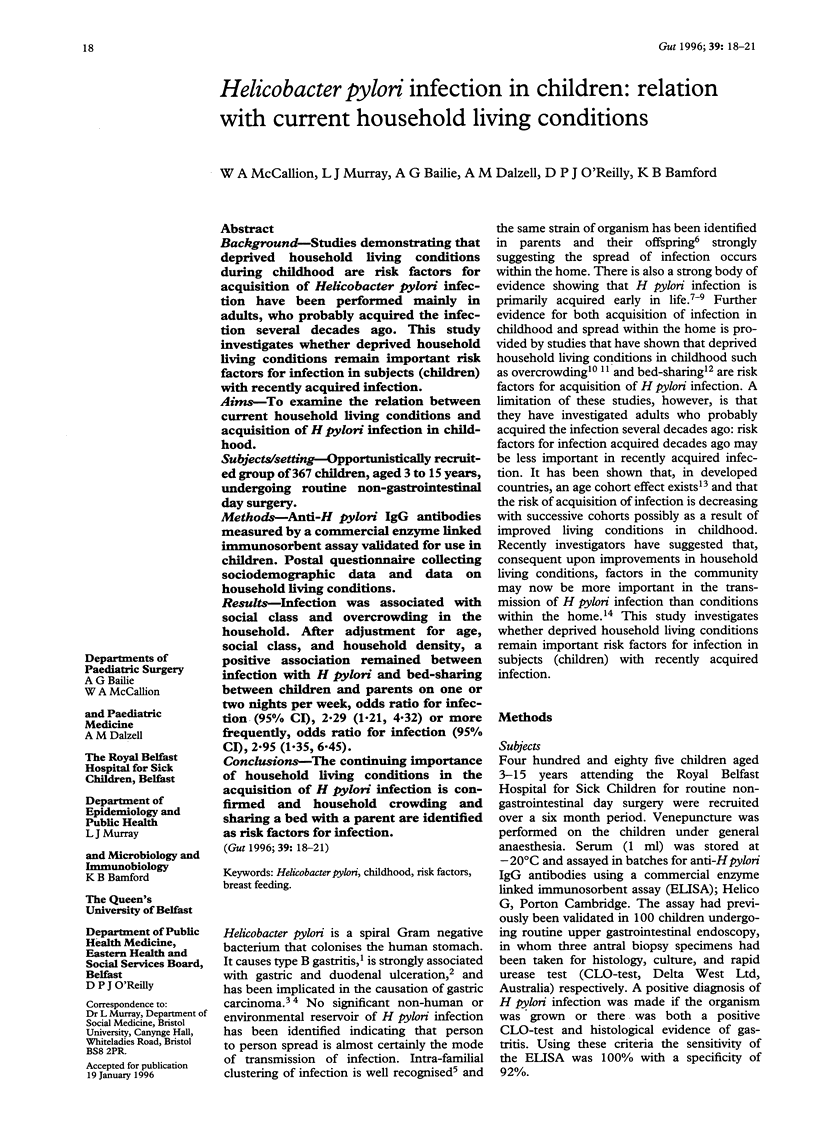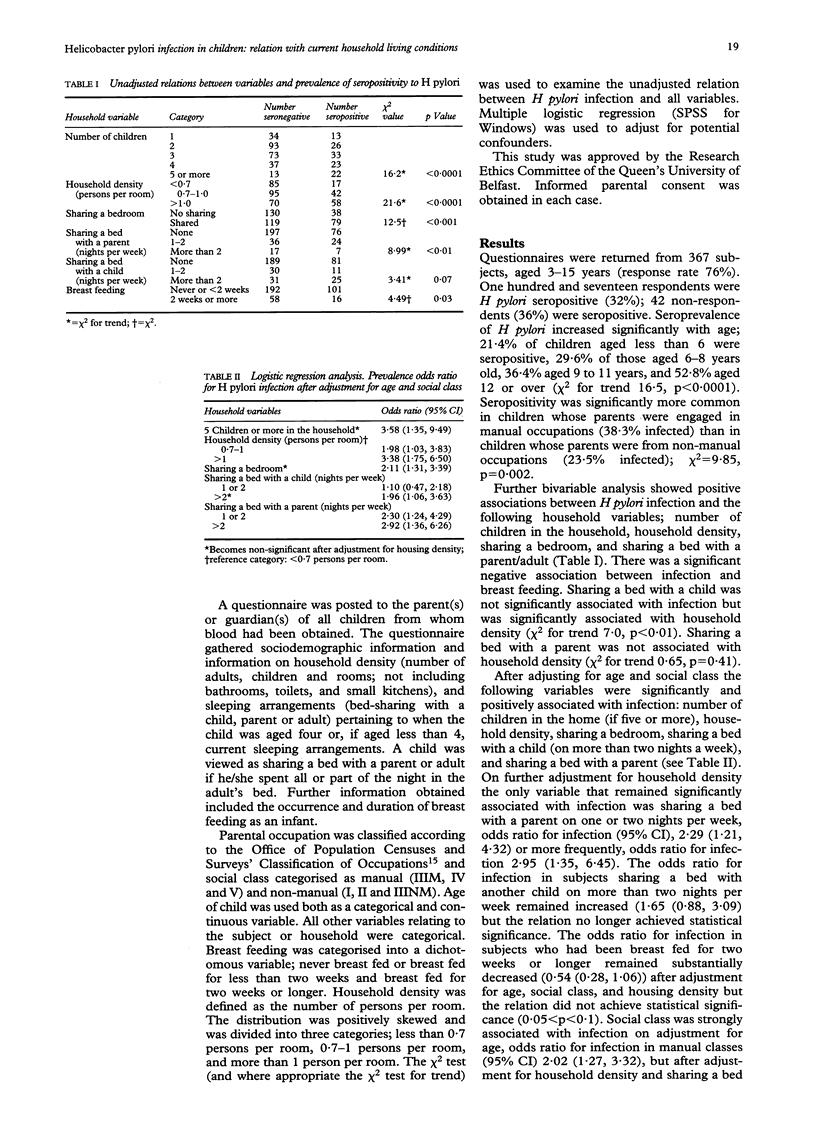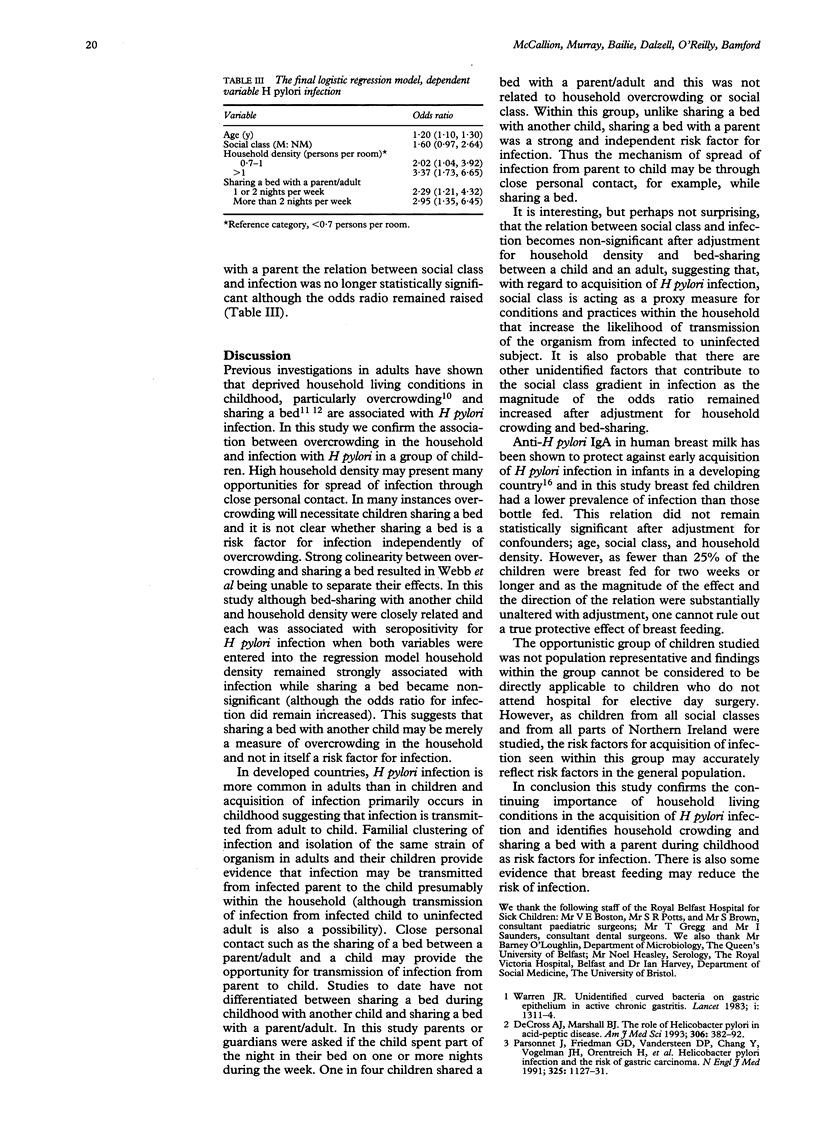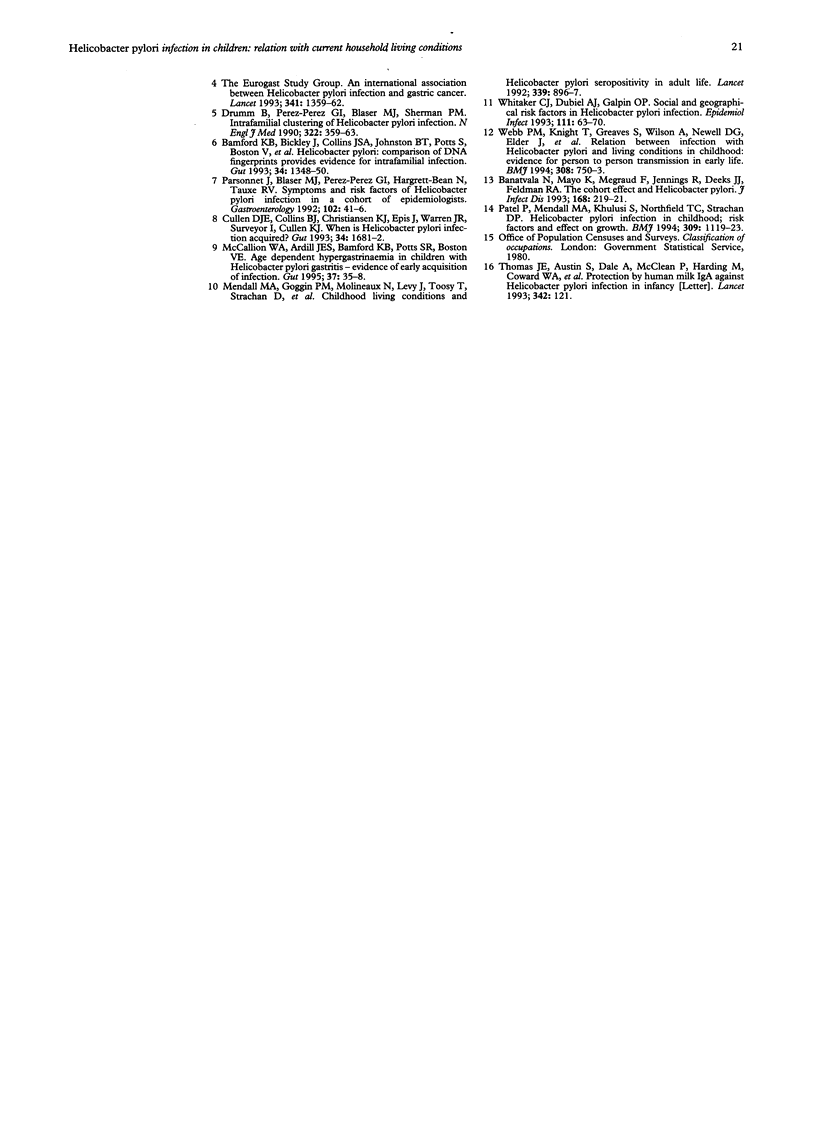Abstract
BACKGROUND: Studies demonstrating that deprived household living conditions during childhood are risk factors for acquisition of Helicobacter pylori infection have been performed mainly in adults, who probably acquired the infection several decades ago. This study investigates whether deprived household living conditions remain important risk factors for infection in subjects (children) with recently acquired infection. AIMS: To examine the relation between current household living conditions and acquisition of H pylori infection in childhood. SUBJECTS/SETTING: Opportunistically recruited group of 367 children, aged 3 to 15 years, undergoing routine non-gastrointestinal day surgery. METHODS: Anti-H pylori IgG antibodies measured by a commercial enzyme linked immunosorbent assay validated for use in children. Postal questionnaire collecting sociodemographic data and data on household living conditions. RESULTS: Infection was associated with social class and overcrowding in the household. After adjustment for age, social class, and household density, a positive association remained between infection with H pylori and bed-sharing between children and parents on one or two nights per week, odds ratio for infection (95% CI), 2.29 (1.21, 4.32) or more frequently, odds ratio for infection (95% CI), 2.95 (1.35, 6.45). CONCLUSIONS: The continuing importance of household living conditions in the acquisition of H pylori infection is confirmed and household crowding and sharing a bed with a parent are identified as risk factors for infection.
Full text
PDF



Selected References
These references are in PubMed. This may not be the complete list of references from this article.
- Bamford K. B., Bickley J., Collins J. S., Johnston B. T., Potts S., Boston V., Owen R. J., Sloan J. M. Helicobacter pylori: comparison of DNA fingerprints provides evidence for intrafamilial infection. Gut. 1993 Oct;34(10):1348–1350. doi: 10.1136/gut.34.10.1348. [DOI] [PMC free article] [PubMed] [Google Scholar]
- Banatvala N., Mayo K., Megraud F., Jennings R., Deeks J. J., Feldman R. A. The cohort effect and Helicobacter pylori. J Infect Dis. 1993 Jul;168(1):219–221. doi: 10.1093/infdis/168.1.219. [DOI] [PubMed] [Google Scholar]
- Cullen D. J., Collins B. J., Christiansen K. J., Epis J., Warren J. R., Surveyor I., Cullen K. J. When is Helicobacter pylori infection acquired? Gut. 1993 Dec;34(12):1681–1682. doi: 10.1136/gut.34.12.1681. [DOI] [PMC free article] [PubMed] [Google Scholar]
- Drumm B., Perez-Perez G. I., Blaser M. J., Sherman P. M. Intrafamilial clustering of Helicobacter pylori infection. N Engl J Med. 1990 Feb 8;322(6):359–363. doi: 10.1056/NEJM199002083220603. [DOI] [PubMed] [Google Scholar]
- McCallion W. A., Ardill J. E., Bamford K. B., Potts S. R., Boston V. E. Age dependent hypergastrinaemia in children with Helicobacter pylori gastritis--evidence of early acquisition of infection. Gut. 1995 Jul;37(1):35–38. doi: 10.1136/gut.37.1.35. [DOI] [PMC free article] [PubMed] [Google Scholar]
- Mendall M. A., Goggin P. M., Molineaux N., Levy J., Toosy T., Strachan D., Northfield T. C. Childhood living conditions and Helicobacter pylori seropositivity in adult life. Lancet. 1992 Apr 11;339(8798):896–897. doi: 10.1016/0140-6736(92)90931-r. [DOI] [PubMed] [Google Scholar]
- Parsonnet J., Blaser M. J., Perez-Perez G. I., Hargrett-Bean N., Tauxe R. V. Symptoms and risk factors of Helicobacter pylori infection in a cohort of epidemiologists. Gastroenterology. 1992 Jan;102(1):41–46. doi: 10.1016/0016-5085(92)91782-y. [DOI] [PubMed] [Google Scholar]
- Parsonnet J., Friedman G. D., Vandersteen D. P., Chang Y., Vogelman J. H., Orentreich N., Sibley R. K. Helicobacter pylori infection and the risk of gastric carcinoma. N Engl J Med. 1991 Oct 17;325(16):1127–1131. doi: 10.1056/NEJM199110173251603. [DOI] [PubMed] [Google Scholar]
- Patel P., Mendall M. A., Khulusi S., Northfield T. C., Strachan D. P. Helicobacter pylori infection in childhood: risk factors and effect on growth. BMJ. 1994 Oct 29;309(6962):1119–1123. doi: 10.1136/bmj.309.6962.1119. [DOI] [PMC free article] [PubMed] [Google Scholar]
- Thomas J. E., Austin S., Dale A., McClean P., Harding M., Coward W. A., Weaver L. T. Protection by human milk IgA against Helicobacter pylori infection in infancy. Lancet. 1993 Jul 10;342(8863):121–121. doi: 10.1016/0140-6736(93)91327-i. [DOI] [PubMed] [Google Scholar]
- Webb P. M., Knight T., Greaves S., Wilson A., Newell D. G., Elder J., Forman D. Relation between infection with Helicobacter pylori and living conditions in childhood: evidence for person to person transmission in early life. BMJ. 1994 Mar 19;308(6931):750–753. doi: 10.1136/bmj.308.6931.750. [DOI] [PMC free article] [PubMed] [Google Scholar]
- Whitaker C. J., Dubiel A. J., Galpin O. P. Social and geographical risk factors in Helicobacter pylori infection. Epidemiol Infect. 1993 Aug;111(1):63–70. doi: 10.1017/s0950268800056685. [DOI] [PMC free article] [PubMed] [Google Scholar]


